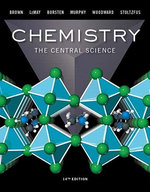?For each of the following balanced oxidation-reduction reactions, (i) identify the oxidation numbers for all the elements in the reactants a
Chapter 20, Problem 20.18(choose chapter or problem)
For each of the following balanced oxidation-reduction reactions,
(i) identify the oxidation numbers for all the elements in the reactants and products and
(ii) state the total number of electrons transferred in each reaction.
(a) \(2 \mathrm{MnO}_{4}^{-}(a q)+3 \mathrm{~S}^{2-}(a q)+4 \mathrm{H}_{2} \mathrm{O}(l) \longrightarrow 3 \mathrm{~S}(s)+ 2 \mathrm{MnO}_{2}(s)+8 \mathrm{OH}^{-}(a q)\)
(b) \(4 \mathrm{H}_{2} \mathrm{O}_{2}(a q)+\mathrm{Cl}_{2} \mathrm{O}_{7}(g)+2 \mathrm{OH}^{-}(a q) \longrightarrow 2 \mathrm{ClO}_{2}^{-}(a q)+ 5 \mathrm{H}_{2} \mathrm{O}(l)+4 \mathrm{O}_{2}(g)\)
(c) \(\mathrm{Ba}^{2+}(a q)+2 \mathrm{OH}^{-}(a q)+\mathrm{H}_{2} \mathrm{O}_{2}(a q)+2 \mathrm{ClO}_{2}(a q) \longrightarrow \mathrm{Ba}\left(\mathrm{ClO}_{2}\right)_{2}(s)+2 \mathrm{H}_{2} \mathrm{O}(l)+\mathrm{O}_{2}(g)\)
Text Transcription:
2 MnO4 -(aq) + 3 S2 - (aq) + 4 H2O(l) \longrightarrow 3 S(s) + 2 MnO2(s) + 8 OH-(aq)
4 H2O2(aq) +Cl2O7(g) +2 OH-(aq) \longrightarrow 2 ClO2 -(aq)+ 5 H2O(l) + 4 O2(g)
Ba2+(aq) + 2 OH-(aq) + H2O2(aq) + 2 ClO2(aq) \longrightarrow Ba(ClO2)2(s) + 2 H2O(l) + O2(g)
Unfortunately, we don't have that question answered yet. But you can get it answered in just 5 hours by Logging in or Becoming a subscriber.
Becoming a subscriber
Or look for another answer
